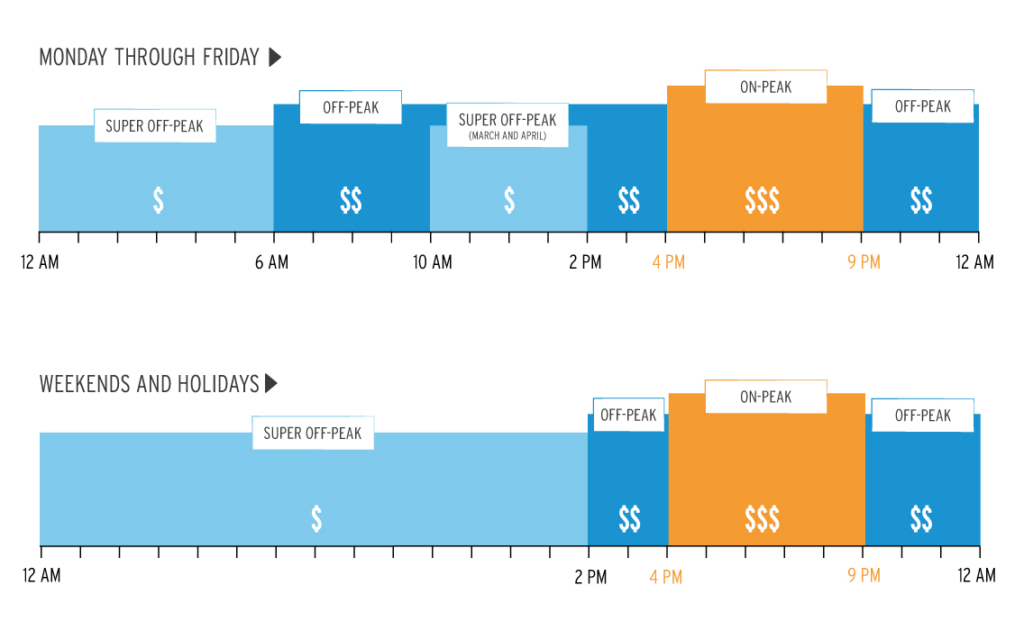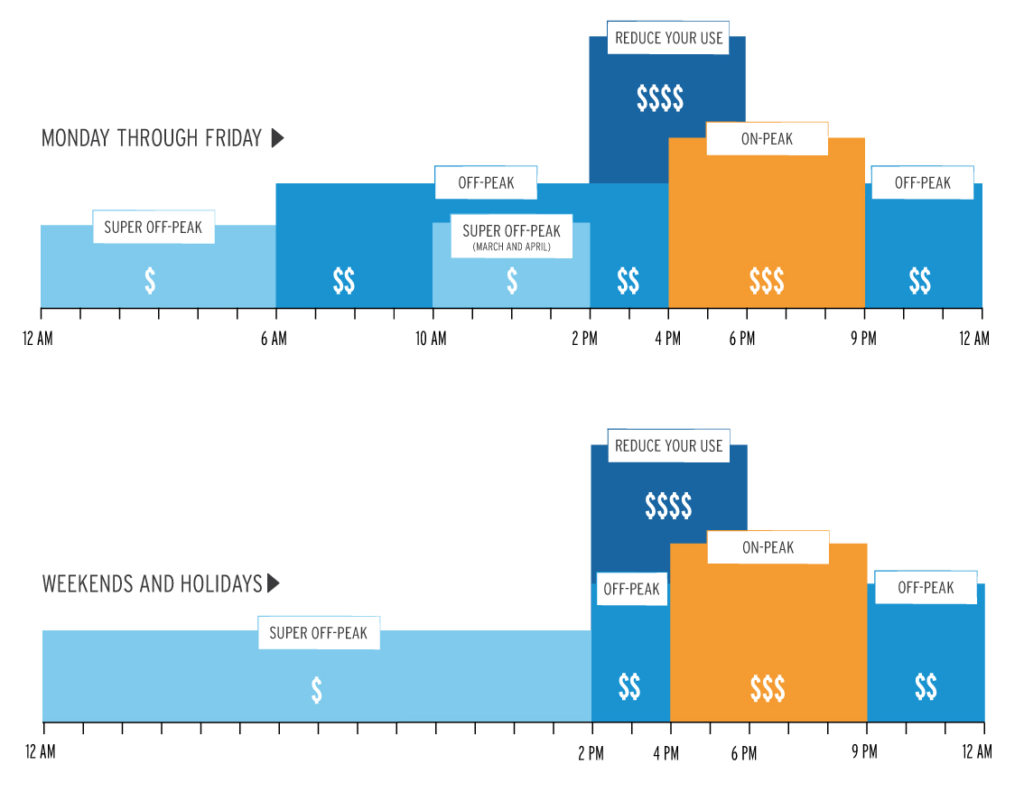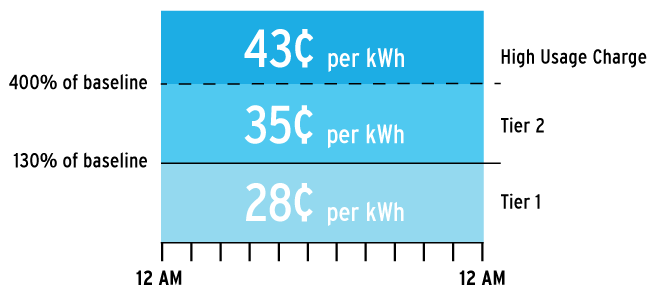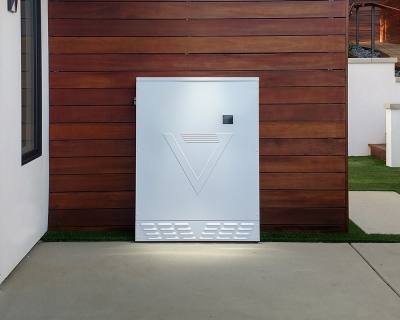SDGE Time Of Use, How Does This Affect You?
Under TOUs, the time of the day will determine how much you pay for electricity.
SDG&E customers transition from a tiered billing system to a time of use rate structure.
Time Of Use SDGE Rate Structure
What Is TOU
SDGE TOU (SDGE Time Of Use plan) is an energy pricing plan where energy rates are based on the time in which energy is being consumed.
The large majority of the population is away at work or school during the day, resulting in decreased energy consumption from the grid during the day. When people get home in the afternoons, they may turn on the A/C, charge their electronic devices, wash/dry laundry, watch TV, play video games, and generally make use of their home. In the evening, energy load is at its highest, and demand peaks. Following the supply and demand principle, as demand increases and supply decreases the price will go up.
In 2013, SDG&E was granted authority to implement a time of use rate structure through legislature passing Assembly Bill 327 to reform residential rates.
SDGE offers three different time of use pricing plans (TOU-DR1, TOU-DR2 and TOU-DR-P).
If customers do not make a choice they will default to the TOU-DR1 time of use plan.
TOU-DR1

As you can see from the graph there are three different SDG&E time of use rates, SDG&E time of use hours are:
- On-Peak – From 4 p.m. – 9 p.m. pricing will be the highest. This is when demand on the grid peaks when a big portion of the population gets home.
- Off-Peak – From 6 a.m. – 4 p.m. and 9 p.m. – 12 a.m. pricing will be in the middle. This is usually when a lot of people are at work or school.
- Super Off-Peak – From 12 a.m. – 6 a.m. pricing will be the lowest when most of the population is sleeping.
SDG&E Off-peak hours and super off-peak hours vary by weekdays, weekends and holidays.
For most customers, this change can increase prices DRAMATICALLY! You pay almost double the price for using the same amount of electricity during On-Peak (4 p.m. – 9 p.m.) compared to Super Off-Peak (12 a.m. – 6 a.m.).
TOU-DR2

TOU-DR2 is comprised of two pricing levels:
- On-Peak – 4 p.m. – 9 p.m.
- Off-Peak – 12 a.m. – 4 p.m. and 9 p.m. – 12 a.m.
TOU-DR-P

TOU-DR-P is comprised of four pricing levels:
- On-Peak – 4 p.m. – 9 p.m.
- Off-Peak – 12 a.m. – 4 p.m. and 9 p.m. – 12 a.m.
- Super Off-Peak – 12 a.m. – 4 p.m. and 9 p.m. – 12 a.m.
- Reduce Your Use Day Event – TBD
Reduce Your Use Events are days that may be called by SDGE when energy use and demand from the grid is particularly high. During these events, there is a $1.16 rate increase. These rates are only applicable during a Reduce Your Rate Event, which can only be called 18 times a year.
Why is Time Of Use SDG&E Being Implemented?
SDGE time of use plans are being implemented to control consumer behavior regarding energy consumption in order to ease the strain of the energy load at high demand times. By charging a higher rate for electricity between 4 p.m. and 9 p.m during SDG&E peak times, SDGE hopes they can persuade people to reduce their energy use.
The utility companies claim they can save you money by shifting your energy patterns to different days and times, but in reality, that isn’t convenient for people. We all lead busy lives and it isn’t always possible for someone to wait to do laundry or wash their dishes, or run their AC even, until midnight. Last summer San Diegans experienced record-breaking high electric bills, thanks to the sweltering hot days and the necessity to run their AC.
With these inconvenient and excessive TOU’s, it’s important to look toward alternative energy sources to reduce your reliance on the utility. Gaining energy independence from the utility starts with solar. Californians can go solar and take advantage of the 26 percent federal solar tax credit that’s still available to customers., which will greatly reduce the cost of your new solar installation.
For more information about TOU’s, solar and the 26 percent federal solar tax credit, give us a call at (619) 743-9193 or click here to get in contact with someone at SolarTech.
*images courtesy of SDGE
TOU In Action
Our example customer:
- Used a total of 950 kWh for the month
- Has an 130% base line of 394 kWh

At the end of the month, we calculated what the customer would be expecting to pay by multiplying their energy usage by SDGE’s cost per kWh, based on SDGE’s time-of-use rates. The total come out to $382 of billable electricity. SDG&E offers a baseline credit of up to 130% of their usage to their account. Their 130% baseline was set as 394 kWh which resulted in a $74.86 credit. We then subtracted the $74.86 credit from their total usage of $382 to get their final bill of $308.
After running this case study, we found that a customer that is working a traditional work schedule (9 a.m. – 5 p.m.) is at a high risk of paying egregiously expensive electricity bills. If you use the majority of your electricity when you get home (4 p.m. – 9 p.m.), being on the TOU plan will make your bill more expensive than it was previously on a tiered billing structure.
SDGE Time Of Use Pricing Examples
As you can see from the graph, the baseline is still in effect with the new TOU implementation. You are given a certain “energy allowance” that you can use up 130% of it. If you exceed this limit, each kWh is more expensive in the next pricing tier. Each customer’s baseline can vary depending on location and season. If interested, you can calculate your SDG&E allowance by using this SDG&E Baseline Calculator.

Am I Really Saving Money Or Spending More?

Under CPUC rules, customers are backed by a special bill protection plan.
For an entire year after customers have transitioned to time of use plans, SDG&E will include a “shadow bill” in their monthly statements that shows them the exact difference between what they paid under TOU and what they would have paid under the traditional tiered billing structure.
If the customer ended up paying more for their TOU plan than they would have under their traditional plan, SDGE will credit them the difference at the end of the year.
For someone who works a traditional 9 to 5, you’re at risk of paying very expensive rates for your energy use under SDGE’s new time-of-use rate structure.
How Does TOU Differ From the Past?
Time of use is a relatively new billing structure. Traditionally, SDGE customers have been on a tiered billing structure. SDGE rates worked by having multiple tiers with different prices of energy. The more energy you consume, the more you’ll be charged within your given tier. Similar to our tax bracket, the more money you make the more tax you will have to pay.Consumers today are paying far more for their electricity than they have in the past and SDGE’s time-of-use rates are only exacerbating this issue.

Prices are effective June 1, 2020, and will run through October 31 or longer, if extended by the Commission.
Net Metering & Time of Use
What is Net Metering? Am I Grandfathered?
All residential ratepayers who have already installed a solar energy system are interconnected under Net Metering (NEM 1.0 or NEM 2.0/ST). This agreement between the customer and the utility is designed so that you will receive retail rates credited to you for energy exported to the grid.
To put this into perspective, a typical home consumes about 60%-70% of the solar energy it produces “behind the meter” (also known as immediate on-site consumption). The remaining electricity is sent out to the grid and the utility is required to credit your NEM account at the full price a residential customer would pay per kilowatt-hour. When you need energy at night or when your solar isn’t producing, you buy (import) energy from the utility at retail price.
Though Net Metering for your solar energy system is grandfathered for 20 years, the utilities have found a way around that by moving solar customers to Time-of-Use. This will allow them to provide less value for electricity that you export to the grid during the day, while charging the most expensive rates for electricity you use when solar panels are generally not producing much energy.
All customers who have already installed solar still have Net Metering grandfathered for 20 years from the date your system was activated with the utility. Customers who installed before 3/30/18 and selected the DR-SES (solar TOU) rate structure also have 5-year rate protection before defaulting to current Time-of-Use periods. Most solar owners, however, have stayed on the standard tiered rate structure. We’ve spoken at length with SDGE representatives, and it is our understanding that these customers will be able to stay on the DR rate structure for up to 20 years (as long as it is offered by the utility).
How Does This Affect Me?
Depending on when you installed solar and which rate structure you are currently on, you will be transitioned to a new Time-of-Use rate structure on the 5-year anniversary of your system activation or you may be able to stay on the tiered structure longer. When this happens, you will most likely notice a change in the credit you receive for exported energy and you may see an increase in your overall bill with the utility. Rest assured, your solar investment was still a wise choice. Residential ratepayers without solar are going to feel the impact of Time-of-Use much more than customers who have already installed solar.
What Can I Do?
While we cannot communicate with the utilities on your behalf, we’ve prepared several pertinent questions for you to call and ask a representative from SDGE/SCE:
- What rate structure am I currently on?
- How long am I protected under my current rate structure? (This is different than the 20-year grandfathering for Net Metering).
- When was my system activated?
- Are there any rate options available to me with longer protections?
- (If yes) Will I be able to switch back to my current rate structure in the future if the new rate structure isn’t a better value for me?
Protect Your Solar Investment By Installing Solar Energy

SolarTech’s Recommendation is to consider installing a home solar battery backup along with your solar energy system, especially for customers who are reaching or have passed the 5-year mark from when their solar was installed.
Customers can protect themselves from upcoming rate changes and price hikes by installing a battery system that stores solar energy produced during the day and discharges that electricity for use during On-Peak rate periods in the afternoon/evening.
Every kilowatt-hour produced by the solar panels that you keep for yourself becomes more valuable, instead of passing it on to the export/import exchange with the utility. Take the next step toward energy independence and protect yourself from the volatility of utility pricing by installing home energy storage.
Energy storage also carries the MAJOR benefit of providing emergency home backup power for when the grid fails.
Due to the heightened demand for home battery systems, SolarTech is taking reservations on a first-come-first-served basis.
Call 619-743-9193 or click below to protect your investment and secure your energy independence now. The 26% federal tax credit is available through the end of this year and can be applied toward your energy storage system when paired with solar (consult your tax advisor for more details). SGIP Rebates from the State of California are also still available or waitlisted for customers, and about $700M more in funding is coming for this program as well.

